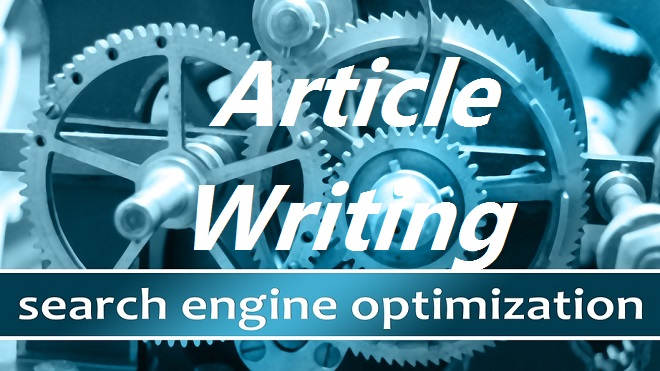Article Writing For SEO-Optimization

Do you want to write articles that are search engine optimized?
Ranking high in the search engines for a keyword by writing an article that is SEO-optimized is the goal of all content creators. If you can make your article rank in the number one spot on Google it is something to be proud of. If you want to write a high-performance article that rockets ahead of your competition, you must use your creative mind, and your logical mind together to engage in article writing. You must go through the steps the same as a professional driver would, to propel his car ahead of everyone else.
Let’s begin by shifting through the gears of SEO to propel our article to the top of search engine results where your article belongs.
eBook Guidance is reader-supported. When you buy through links on our site, we may earn an affiliate commission. As an Amazon Associate, I earn from qualifying purchases. Affiliate Disclosure
Seven Steps to Article Writing that is SEO-Optimized
First Gear - Identify Your Keywords.
Let’s shift your article writing into first gear and begin by choosing the right keywords for your article.Finding the right keyword is the first, and most important task if you want to rank high in the search engines. Start by typing a search inquiry into Google related to your niche.
If you have a blog in the Health and Nutrition niche, for instance, you could type, “fruits with” into Google, and Google will present options such as fruits with low sugar, fruits with Vitamin C, fruits with high fiber… etc.

This predictive text is based on other popular inquiries that people have typed into Google. This predictive text will offer you many great ideas for articles to write for your blog, but how many people are searching for these long-tail keywords?
Second Gear - Keyword Research
It is time to shift gears and increase momentum. Keyword research is the next tool you will need to write articles that you can optimize to rank high in the search engines.You must do the research to learn how many monthly searches your keyword is getting, what the trend of these searches are, and how difficult it will be to rank for those keywords.
The best tool that I have found to perform keyword research is kwfinder.com
I wrote more detailed information about KWFinder entitled How to make money writing from home - blogging.
After you have done your keyword research and found out who your competitors are, you can read what they wrote, and analyze why Google ranked them so high.
Third Gear–Place Your Keywords In Your Article.
Shift gears again now into 3rd as you continue to focus on writing SEO-optimized articles.
Keyword density is the number of times your keyword appears in your article. For best search engine optimization, your keyword density should be between 1–2%. This means for a 1500 word article your keyword should appear at least 15 times, but no more than 30 times.
It should be noted that it is easier to rank for long-tail keywords than it is for a single keyword.
Fruit would be a very difficult term to rank for.
Fruits with high fiber is a more long-tail keyword that would still be difficult to rank, but easier than the single word fruit.
Fruits with high fiber in Thailand is even more long-tail and specific, making it even easier to rank for.
When using the long-tail keyword phrase to rank your article, don’t use the whole phrase to meet your goal of a 1–2% keyword density, or your article will look like spam.
Use it in your Title and heading and a few times in the body of a 1500 word blog post, but then break it down. Use phrases while you’re writing such as, “Fruits high in fiber”, “Fruits from Thailand”, you get the idea.
Where should I add keywords in my article?
Place your keywords in the title first, and then the heading. The title is what viewers will see first in large boldface font when they do a Google search for what they are looking for.
The heading is the boldface text in your H1 tag your viewers will see first when they view your webpage. Assuming you started your blog post off with an h1 heading.
The title and heading don’t have to be the same. When someone does a Google search and finds your content they may see, “7 Fruits with high fiber in Thailand”, but when they visit your blog your headline reads, “7 Fruits you must try in Thailand that are high in fiber”
The H1 tag is the largest heading size, you can create a secondary heading with an H2 tag. This will create a slightly smaller text that still holds weight in search engine optimization. Something you might want to add to the H2 tag, in this case, is “Are you getting enough fiber from the foods you eat?”
Displaying slightly smaller in size is an H3 tag. These are great to use when starting a new topic to write about, or in the case of numbered posts, starting each number with an H3 tag helps Google to understand this is an important portion of your article.
Using keywords in your title, heading, sub-heading, and H3 tags is a great way to rank better in search engines.
Fourth Gear–Article Length
We are moving now. Do you feel those vibrations? It’s time to shift into fourth gear if you want to continue to speed up ahead of your competition. Now it is time to take what you have learned so far and write an article optimized for search engines.
Google likes long-form content that thoroughly answers or best matches what the viewer is looking for. Writing a short 300-word article is going to be thin content, and won’t rank well in Google. Brian Dean from Backlinko researched SEO-optimization and found the average word count of a Google top 10 search is 1447.
Keep in mind the search intent of your viewers as you are writing your article. If you can completely answer your viewer’s question, and they stay on your page long enough to read your whole article you will rank higher in Google.
Fifth Gear–Images With Your Keyword in Alt-tags
Continuing our momentum, we shift into fifth gear by adding images to our article.
A picture is worth a thousand words, adding images to your article will make them more interesting. Don’t do a Google images search and use a random image, or steal somebody else’s image. You can find countless royalty-free images on websites such as Pixabay.
Use images that relate to your keyword and place your keyword in your alt-tag.
Sixth Gear–Interlinking
We are almost there. Now it is time to shift into sixth gear and add links to articles we have written before. It is also a good idea to go back to the articles you have written before and adding a link to your new article.
By linking to other articles that you have written you are doing on-page-Seo which will give more credibility to your content and help your readers find your content more easily.
Seventh Gear–Get backlinks With Your Keywords in the Anchor Text
The seventh and final gear we need to shift into involves getting backlinks to our article. The easiest way to do this is to comment on other blogs in your niche that allow blog commenting and a backlink in your comment.
You can check your backlinks on the website ahrefs Backlink Checker.
The best backlinks come from other blogs that link back to you with a do-follow link and use the keyword you want to rank for in their clickable link to your article.
You can get this by writing an amazing article that they want to link to, or you could send them an email asking for a link to your blog.
May all the articles you write be SEO-optimized to rank high on Google.
Related Articles: Previous Article - How to Make Money Writing from Home - Blogging Next Article - National Novel Writing Month EBook Guidance is a participant in the Amazon Services LLC Associates Program, an affiliate advertising program designed to provide a means for sites to earn advertising fees by advertising and linking to Amazon.com.
10 Fail-Proof Strategies to Achieve your Writing Goals
How Do I Start Writing?
What Are Writing Rituals?
Come join us on Facebook Click here...
All links on this site are subject to being sponsored content for which we will receive financial compensation.

